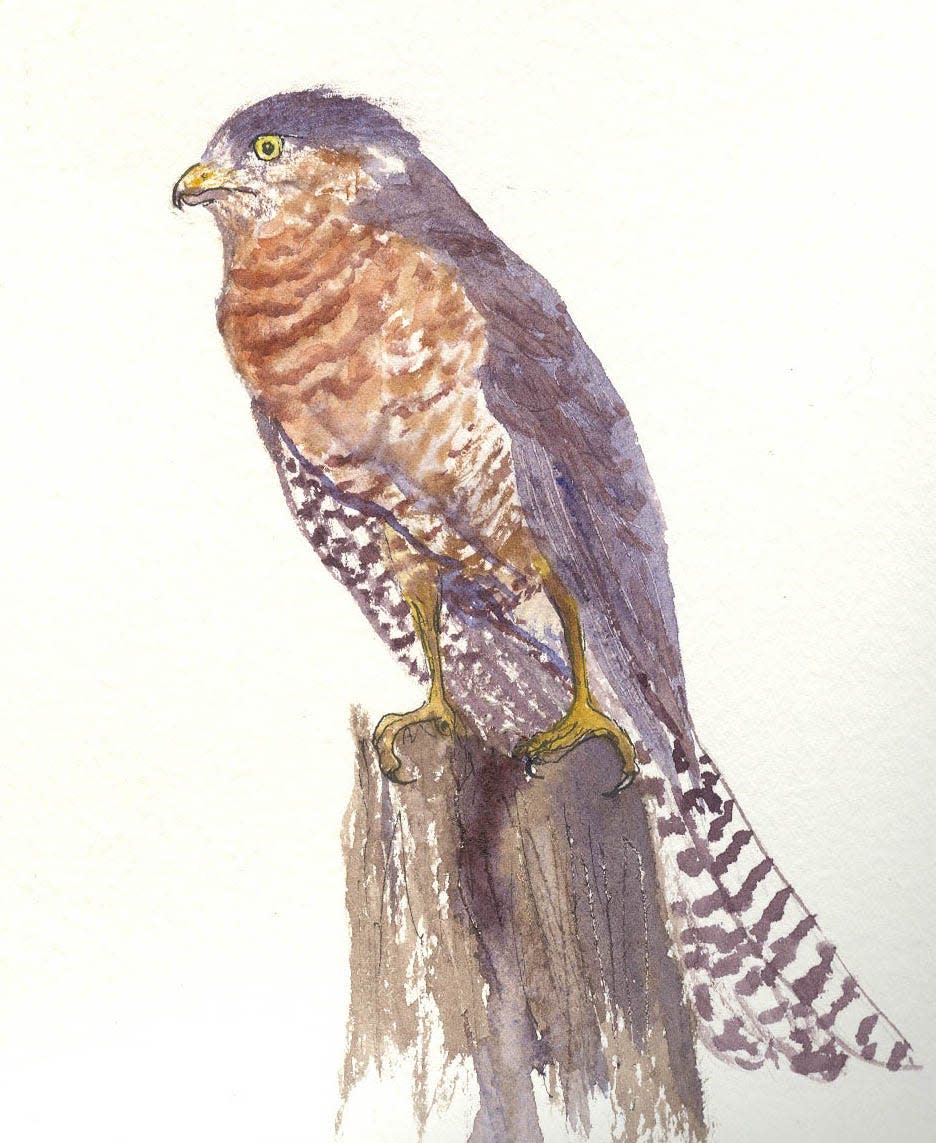Nature Journal: Sharp-shinned hawks seem to appear out of nowhere
While observing your feeders, you may be startled by a “blue flash” that suddenly appears as if from out of nowhere, snatches one of your birds in its talons and disappears. The “blue flash” will be either a sharp-shinned or a Cooper's hawk, the infamous "chicken hawks" of rural lore that feed primarily on other birds. Because of their blue-gray backs and lightning-quick movements, when tracking prey through brush or into a hen house, they were widely known in the rural South as "blue darters." The smaller sharp-shinned hark was the Little Blue Darter while the larger Cooper’s hawk was the Big Blue Darter.
Some readers who reside in the South may have heard the term “blue darter” used to describe a light early-season snow that comes and goes quickly. Baseball fans will have heard the term used to describe a low hard-hit line drive. Readers with an urban background may have heard the term used to describe gas with a high menthol content that has been ignited.

During the Great Depression era of the 1930s, when chickens were essential items in the home economies of most southern families, "chicken hawks" were despised and shot on sight. Writing in Birds of the South (1933), North Carolina naturalist Charlotte Hilton Green — normally a mild-mannered bird-loving sort — flew into a tirade regarding the vices of these species in a chapter titled "Two Bad Hawks":
'The two hawks responsible for the hatred and suspicion which farmers have for birds of prey as a whole are the sharp-shinned and the Cooper's. These two villains of hawkdom are the ones that continuously raid poultry yards and war upon small birds. ... Liking young `fryers' as well as any good southerner, if these hawks once make a successful raid on the poultry yard, they are likely to make daily visits ... either until they literally clean out the farmer, or the farmer brings down the hawk.'
Ornithologist and nature writer Scott Weidensaul thinks the late twentieth century inclination of the "two bad hawks" to ravage bird feeders came about because of the nationwide decline of chicken coops and yards. His description of a sudden “blue darter” attack is vivid:

'Within a few seconds the soothing tapestry disintegrates. What a moment before had been a flock of songbirds gathered peacefully at a feeder is now a frenzy of alarm calls and flashing wings. ... One junco is an instant too slow in fleeing and is pinned to the ground dead, its blood a few flecks on the snow. The sharp-shinned hawk ... daintily plucks its meal and begins feeding.'
The modern bird watcher's reaction is likely to be much the same as that of the old-time chicken owner: outrage! The whole business of chicken predation by hawks has been grossly exaggerated through the years, often as an excuse to blast away in ignorance at any type of hawk or good-sized bird that wandered within range.
Sharp-shinned (10-14 inches in length) and Cooper's hawks (14-20 inches) are similar in appearance. Adults are slate blue above and barred rusty brown beneath, with short rounded wings and long slender tails. Note that the sharp-shinned has a tail squared at the tip and a comparatively shallow irregular wing beat, whereas the Cooper's has a tail rounded at the tip and flies with deep deliberate strokes, often with three flaps and a glide. It prefers a less dense forest environment than the sharp-shinned hawk and will hunt in open areas with greater frequency.
The species entry by Keith L. Bildstein and Ken Meyer for the sharp-shinned hawk at the North American Birds Online site describes the hunting strategies and tactics of our littlest hawk:
'Secretive, opportunistic; relies on surprise. Attacks flying or perched prey. Capture follows short chase or stealthy approach initiated from perch or low-level flight. When hunting from perch, remains motionless until [it] darts rapidly toward quarry, often parting foliage and small branches in the process. Can maintain high speed for short distances. … Uses natural features and man-made structures for cover when approaching prey, often remaining concealed — and obviously unable to see the target — until the last instant. Sometimes hunts speculatively, coursing low against a backdrop of vegetation or rising terrain, winding around shrubs, hedgerows, or tree trunks. Long legs and toes enable individuals to reach into vegetation, and long, deep curved, needle-sharp talons permit quick, sure grasping even while in motion. Sometimes reaches into wire-mesh traps and cages to impale birds within. ... The smallest reported prey was an Anna’s Hummingbird [while] the largest was a Ruffed Grouse. ... A female sharp-shinned captured during spring migration at Whitefish Pond, Michigan, had three porcupine quills through her foot [as the result of what appeared to been an overly ambitious foray].'
Once captured the prey is often carried to a "plucking post" — a branch, log or boulder the hawk uses with regularity as a place to pluck off the feathers or fur before devouring it. Ounce for ounce the Little Blue Darter is matched in persistence and ferocity by the weasel and very few, if any, other animals in the Southern Appalachians.
George Ellison is an award-winning naturalist and writer. His wife, Elizabeth Ellison, is a painter and illustrator who has a gallery-studio at 155 Main St., Bryson City. Contact them at info@georgeellison.com or info@elizabethellisongallery.com or write to 3880 Balltown Road, Bryson City, NC 28713.
This article originally appeared on Asheville Citizen Times: Nature Journal: Sharp-shinned hawks seem to appear out of nowhere

